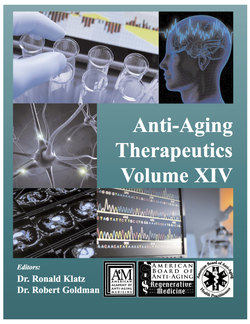Читать книгу Anti-Aging Therapeutics Volume XIV - A4M American Academy - Страница 24
На сайте Литреса книга снята с продажи.
HUMAN NITROGEN CYCLE
ОглавлениеUntil recently it was thought that NO acted only as an autocrine or paracrine mediator due to its extremely short half-life (<1 sec), meaning that it could only act in the cell in which it was produced (autocrine) or a nearby cell (paracrine). Our lab was able to convincingly demonstrate that NO can serve as an endocrine mediator as well. Our report in the Proceedings of the National Academy of Science demonstrates that NO produced in the heart can be transported as nitrite or nitrosothiols and limit liver injury.21 This seminal discovery then allows us to develop novel strategies to replete NO in humans by increasing the transport and delivery of NO through nitrite and nitrosothiols. We have shown that nitrite can also transiently form nitrosothiols (RSNOs) under both normoxic and hypoxic conditions22 and a recent study by Bryan et al demonstrates that steady state concentrations of tissue nitrite and nitrosothiols are affected by changes in dietary nitrite and nitrate (NOx) intake.23 This occurs through a reductive process involving bacteria and human enzymes. In fact this nitrate-nitrite-nitric oxide pathway may be a redundant system for overcoming the body’s inability to make NO from L-arginine.
It appears that we have at least two systems for affecting NO production/homeostasis. The first is through the classical L-arginine-NO pathway. This is a complex and complicated pathway, and if any of the co-factors become limiting, then NO production from NOS shuts down, and in many cases, NOS then produces superoxide instead. The enzymatic production of NO is, indeed, a very complex and coordinated effort that normally proceeds very efficiently. However, in disease characterized by oxidative stress where essential NOS cofactors become oxidized, NOS uncoupling, or conditions of hypoxia where oxygen is limiting, this process can no longer maintain NO production. Therefore, one can argue saliently that there has to be an alternate route for NO production. It is highly unlikely that Nature devised such a sophisticated mechanism of NO production as a sole source of a critical molecule.
This alternate route involves the provision of nitrate and nitrite reductively recycled to NO. Nitrite reduction to NO can occur in a much simpler mechanism than nitrate. The 1-electron reduction of nitrite can occur by ferrous heme proteins (or any redox active metal) through the following reaction:
NO2- + Fe(II) + H+ ↔ NO + Fe(III) + OH-
This is the same biologically active NO as that produced by NOS, with nitrite rather than L-arginine as the precursor and is a relatively inefficient process.24 Therefore, for this reaction to occur, the tissues or biological compartment must have a sufficient pool of nitrite stored. Since plasma nitrite is a direct measure of NOS activity,25 a compromised NOS system can also affect downstream nitrite production and metabolism, which can perhaps exacerbate any condition associated with decreased NO bioavailability. Replenishing nitrate and nitrite through dietary means may then act as a protective measure to compensate for insufficient NOS activity under conditions of hypoxia or in a number of conditions characterized by NO insufficiency. A number of pre-clinical and clinical studies have demonstrated that this dietary strategy is very effective at treating and preventing a number of chronic age-related diseases. Furthermore enriching dietary intake of nitrite and nitrate translates into significantly less injury from heart attack.26 Previous studies also demonstrated that nitrite therapy given intravenously prior to reperfusion protects against hepatic and myocardial ischemia/reperfusion injury.27 Moreover, inhalation of nitrite selectively dilates the pulmonary circulation under hypoxic conditions in vivo in sheep.28 Topical application of nitrite improves skin infections and ulcerations.29 Furthermore, in the stomach, nitrite-derived NO seems to play an important role in host defense30 and in regulation of gastric mucosal integrity.31
All of these studies together along with the observation that nitrite can act as a marker of NOS activity25 opened a new avenue for the diagnostic and therapeutic application of nitrite, especially in cardiovascular diseases, using nitrite as marker as well as an active agent. Oral nitrite has also been shown to reverse N(G)-Nitro-L-arginine-methyl ester (L-NAME)-induced hypertension and serve as an alternate source of NO in vivo.32 In fact, a report by Kleinbongard et al33 demonstrates that plasma nitrite levels progressively decrease with increasing cardiovascular risk. Since a substantial portion of steady state nitrite concentrations in blood and tissue are derived from dietary sources,23 modulation of nitrite and/or nitrate intake may provide a first line of defense for conditions associated with NO insufficiency.34 Indeed, it has been reported that dietary nitrate reduces blood pressure in healthy volunteers.35,36 What is clearly emerging is that there are two pathways for NO production, one through endothelial production via the L-arginine pathway and one through dietary sources of nitrite, nitrate, and antioxidants. This is illustrated in Figure 2. The L-arginine pathway becomes dysfunctional with age, and we, therefore, need a back up system to compensate. Eating a diet rich in NO potential, i.e., sufficient nitrite and nitrate along with antioxidants to facilitate reduction to NO, can appear to overcome an insufficiency in endothelium-derived NO. This dietary pathway does not appear to be affected by age.
Figure 2. The two NO pathways
